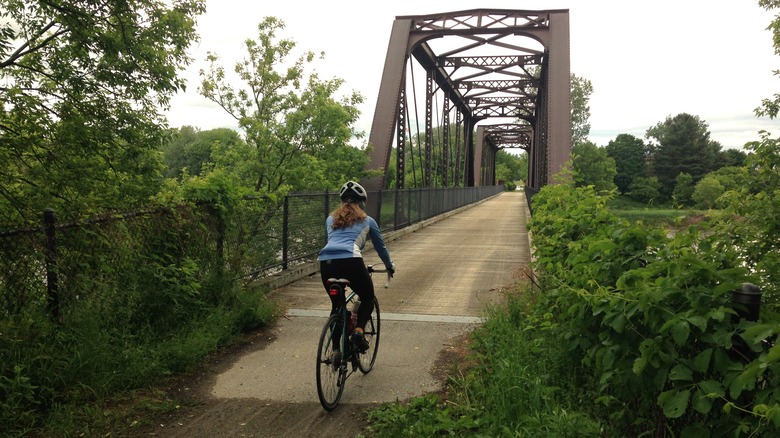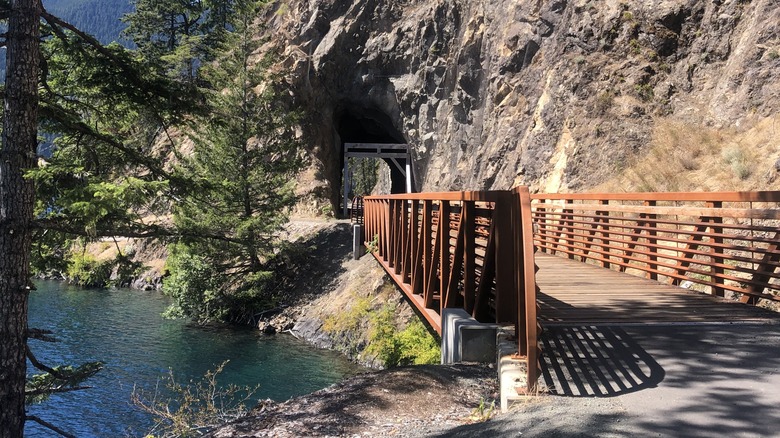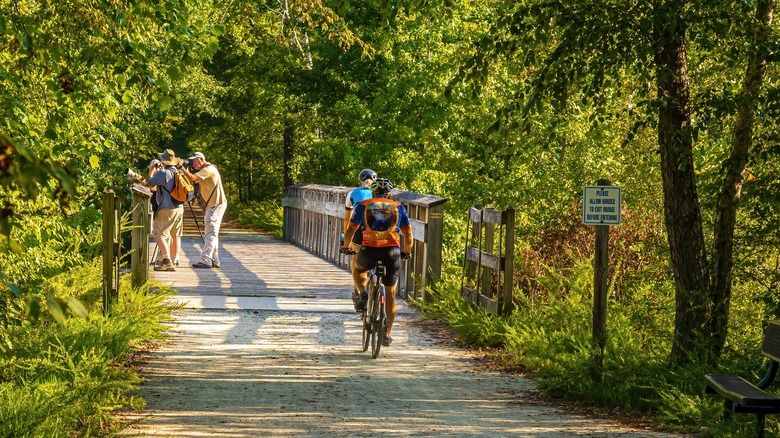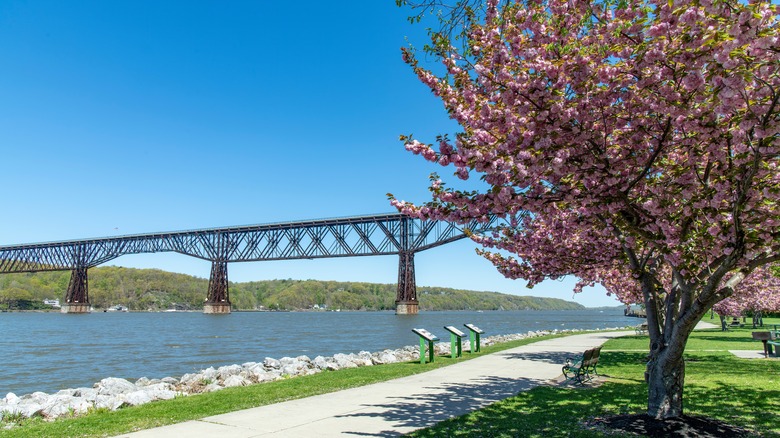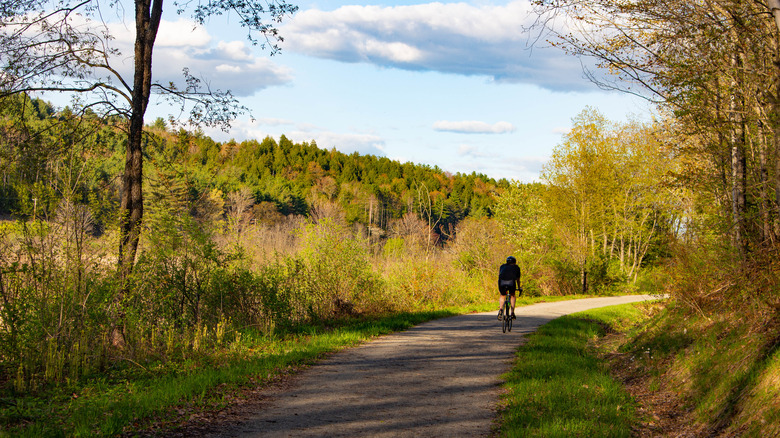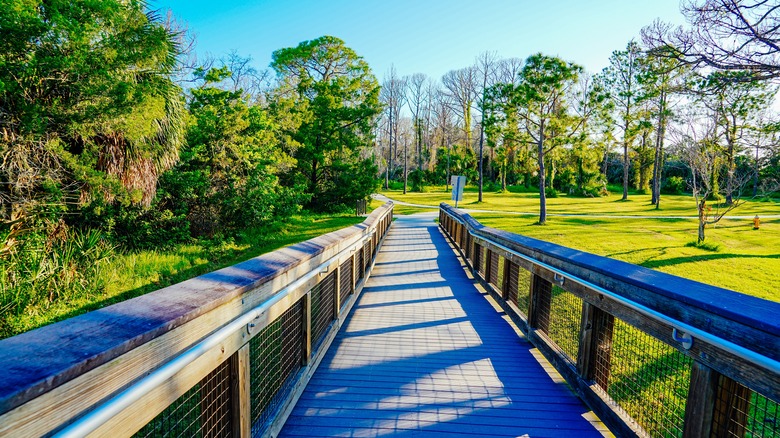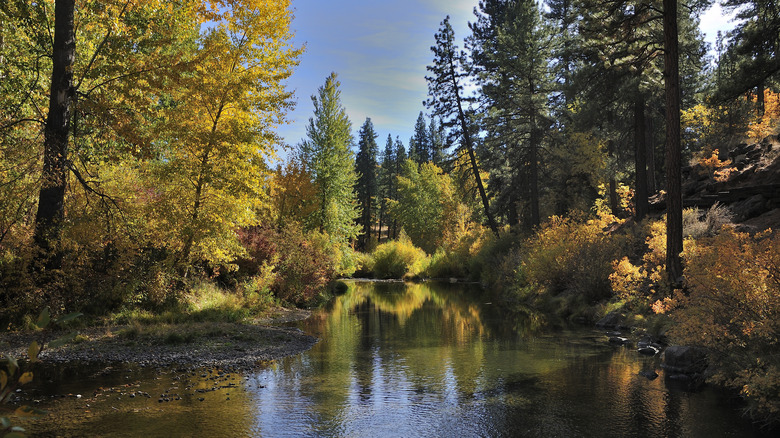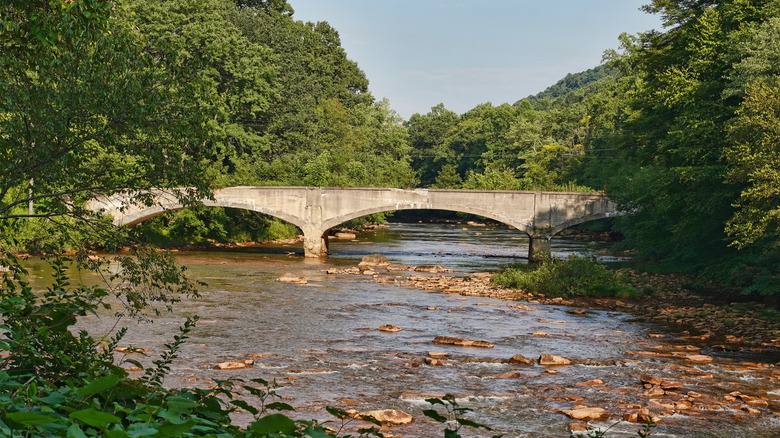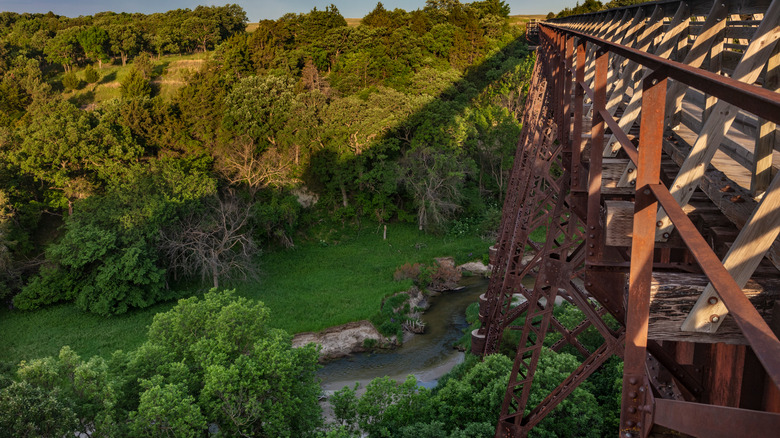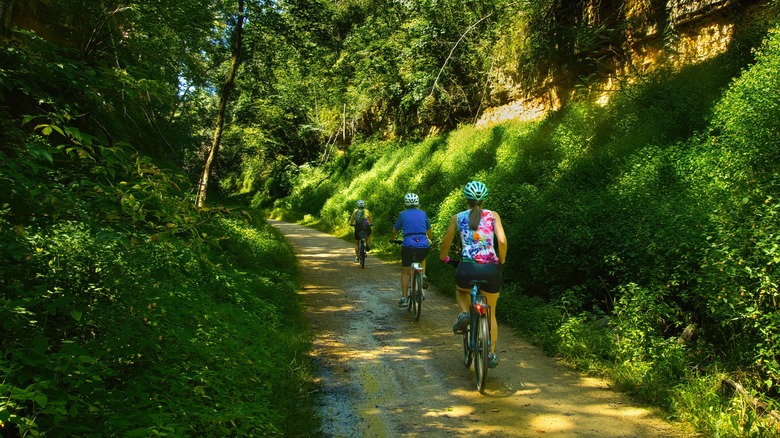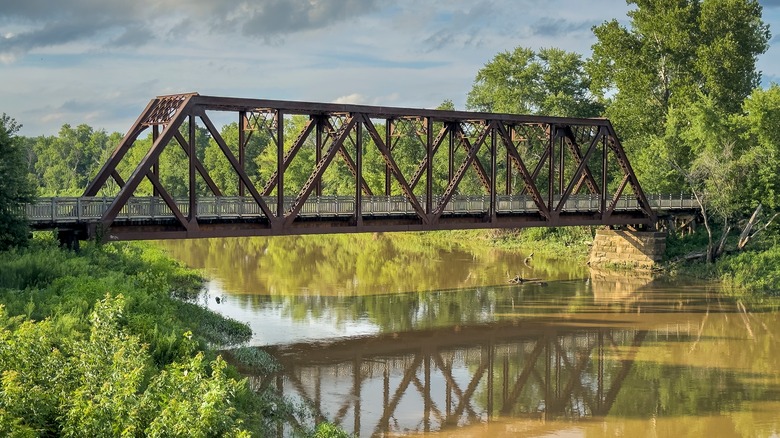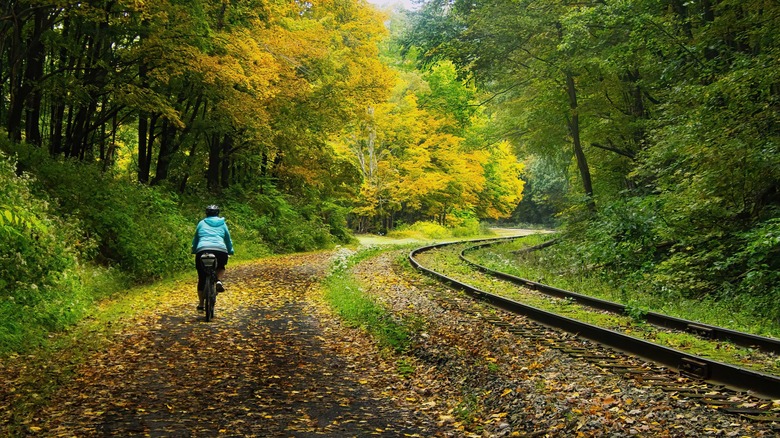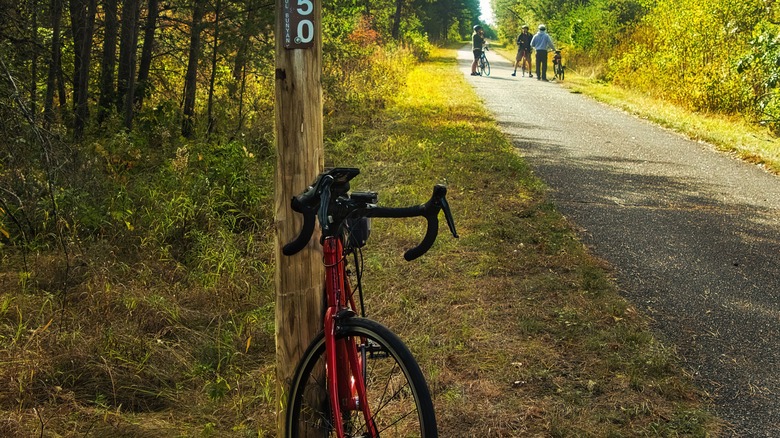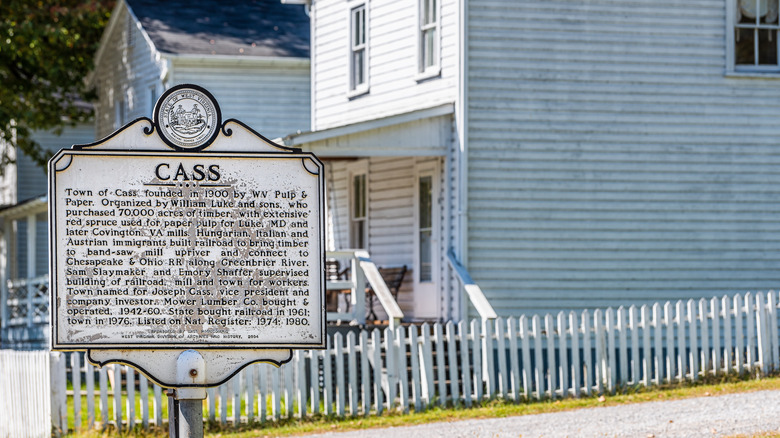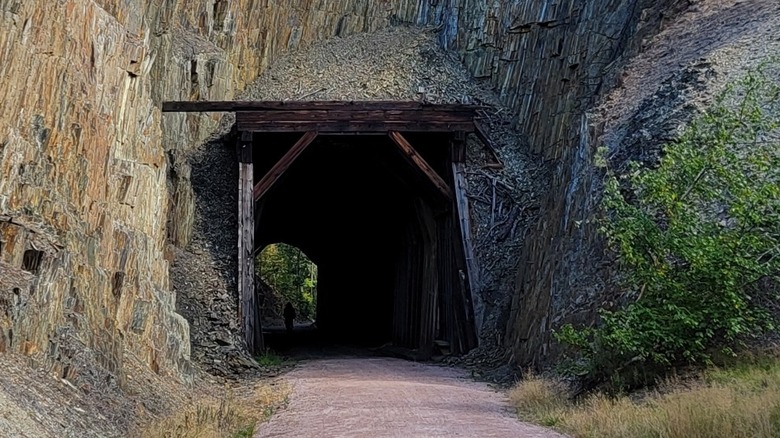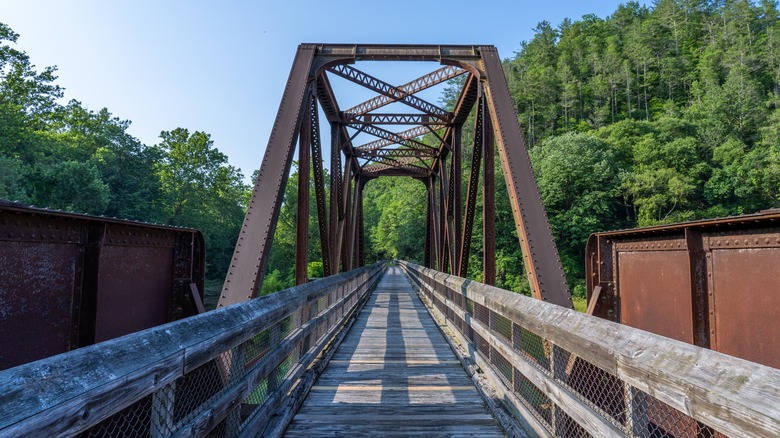The Best Rail Trails In North America, According To Reviews
When an abandoned railroad track gets a little TLC, it can transform into a historic, yet modern, piece of public infrastructure that encourages folks to spend some much-needed time outdoors. Since the 1960s, rail trails in America have been serving commuters and recreationists alike, and each trail comes with its own charm and unique features.
Rail trails are (more or less) linear in nature, making them neat ways to explore multiple towns over one day. With a little preparation, you can even take a multi-day adventure on a long-distance rail trail. Part of these trails' appeal is their easy terrain; they are generally flat, and many of the more popular ones consist of pavement and/or soft gravel. So whether you are a hiker, a biker, a rollerblader, or even a cross-country skier, there is a rail trail out there that is perfect for you.
As a triathlete and a backpacker, I have found myself on many rail trails over the years, and I plan to bike the 3,700-mile Great American Rail-Trail when it is fully complete. I've used my experience and the recommendations of others to compile this list featuring some of the best rail trails in America; more notes on methodology can be found at the end of this article. Covering routes as far apart as Florida and Washington, this guide will help you plan a memorable day trip or vacation, with insider tips to ensure your travels go as smoothly as possible.
Olympic Discovery Trail
If you are a fan of the "Twilight" series, Washington's Olympic Peninsula is probably already on your bucket list. Even if you could care less for vampires or werewolves, the Peninsula is well worth a visit for its dynamic coastline, temperate rainforests, and naturally cool mystique. There is no better way to experience it than by hopping on the Olympic Discovery Trail, a 135-mile long route that stretches from the quaint town of Port Townsend in the east to the Indigenous village of La Push in the west.
While the entire trail is fairly well maintained and scenic, the section that follows Lake Crescent along eight miles of what used to be a railroad is by far the most picturesque segment. You can practically smell history at the McPhee and Dailey-Rankin tunnels. Don't hesitate to stop at Devil's Punchbowl, a swimming hole adjacent to the McPhee tunnel. I recommend biking this section from west to east for exhilarating downhill grades. For accommodations, stay in Port Angeles, one of the best small beach towns in America that is the ideal gateway to Olympic National Park.
American Tobacco Trail
Durham, North Carolina, was built on tobacco and has always been culturally rich, but over the past few decades, it has gained immense popularity as a destination for foodies and artists. This is partly due to the Southern charm that Durham and its residents have always exuded, but also because of the extensive infrastructural renovations the city has recently undergone. One such development is the American Tobacco Trail, which spans more than 22 miles between Durham, Chatham, and Wake Counties.
The trail's northern end is in downtown Durham, just steps from the town's historic American Tobacco Campus. From there, the path is fully paved for about 15 miles until the New Hope Church Road crossing, where it turns to crushed gravel. Folks of all types enjoy the American Tobacco Trail, including commuters, athletes, and families with small children, so obey the 10 mph speed limit if you are on a bike.
Empire State Trail
Whether you're in it for the long haul or just for one day of fun, the 750-mile-long Empire State Trail is a wonderful path for bikers and hikers. The full route has options for recreationists to cross New York State either horizontally or vertically. New York City, Buffalo, and the Canadian border form the three endpoints of this trail, and in between are many serene views of the Hudson River Valley, the Champlain Valley, and the Adirondacks.
Much of the Empire State Trail lies on former railroad beds. The WRS Dutchess Rail Trail, for example, clocks in at 13.5 miles and ends at Walkway Over the Hudson State Park, an awe-inspiring railroad bridge in Poughkeepsie. Continuing west from there, you can stay on the Hudson Valley Rail Trail for an additional seven miles of off-road adventure. Not long after that begins the 13-mile Wallkill Valley Rail Trail, located in an area that was among the 15 best places to see fall foliage in the U.S. in 2024. Combine all three trails for a full day of riding.
Lamoille Valley Rail Trail
On what is officially the longest rail trail in New England, you can soak in the natural wonders of Vermont during all four seasons. Indeed, the newly completed Lamoille Valley Rail Trail is not just for pedestrians and bikers; it's also for horseback riders, snowshoers, snowmobilers, dog sledders, and cross-country skiers. It's a whopping 93 miles long, but relatively flat and primarily consists of smooth gravel.
One end of the trail is based in St. Johnsbury, while the other is in Swanton, with plenty of towns to explore in between. Vermont is known for its bridges, and this trail provides you access to a few. For instance, you can wander through the Fisher Covered Bridge in Wolcott, the last operational covered railroad bridge in the United States. The bridges in Swanton and Morristown are also beautiful. Allot extra time for stopping along the entire rail trail so that you can learn more about the railroad's tumultuous history and why it eventually stopped operating in 1994.
Fred Marquis Pinellas Trail
Rail trails may not be the first thing that comes to mind when you think of Florida, but the Fred Marquis Pinellas Trail proves that former railroad beds can, and should, be enjoyed as multi-use trails nationwide. With one end in St. Petersburg and the other in Tarpon Springs, this 65-mile rail trail is part of the Pinellas Trail Loop, which is scheduled to be completed in the summer of 2025. The northern end of the Pinellas Trail also connects to Florida's Coast-to-Coast Trail, which is likewise nearing completion.
The Fred Marquis Pinellas Trail passes through both public parks and residential neighborhoods, and you'll find yourself stopping often to take pictures of the graceful Spanish moss, wildlife (such as osprey and squirrels), and water features (including the Gulf of Mexico). Tarpon Springs has a charming downtown area, so consider starting or ending your journey there to enjoy its sponge docks and the Leepa-Rattner Museum of Art.
Bizz Johnson National Recreation Trail
This 25.4-mile rail trail in Northern California is a respected member of the Rails to Trails Conservancy's Hall of Fame. It traces the path of the former Fernley and Lassen Railway, following the Susan River. Notable features of the trail include railroad tunnels, muskrat and beaver dams, and over 100 species of birds. Trail users on Tripadvisor recommend packing a wide-brimmed hat and sunscreen since shade is hard to come by, particularly near Susanville.
In the winter, the trail's western section frequently receives enough snow to cover its dirt and gravel surfaces, making it a popular spot for snowmobiling, snowshoeing, and cross-country skiing. Meanwhile, the seven miles that make up the trail's eastern section are considered more wheelchair accessible. In the summer, you'll find hikers, joggers, bikers, and horseback riders enjoying the length of the trail, and you might even see a few people primitive camping. The trail is famous among runners for hosting the Bizz Johnson Marathon, which is fast and mostly downhill.
Ghost Town Trail
Ghost towns aren't just located in the Wild West. Established in 1991, Pennsylvania's 46-mile-long Ghost Town Trail runs past several defunct mining towns in Cambria and Indiana Counties. While many of these ghost towns are on private land and therefore not accessible to the public, trail users can still visit the early 20th-century town of Wehrum. Here, if you look closely, you'll find remnants of streets, buildings, a dam, and a cemetery. In Vintondale, near where the trail splits into the C&I Extension, a trailside exhibit marks a 19th-century iron furnace listed on the National Register of Historic Places.
Visit in the fall, and you'll be treated to beautiful autumnal foliage, especially as it frames the trail's creeks. The Ghost Town Trail is part of the Trans Allegheny Trails network, a collection of 13 rail trails that are worth checking out while you are in the area. When you're ready to get back to civilization, head to the nearby city of Pittsburgh, a pretty city that is a dream come true for art lovers.
Cowboy Trail
Nebraska may not be first on your list when it comes to vacations, but if you're on the market for a long-distance rail trail, let the state's Cowboy Trail introduce to you the unique beauty that can be found here. Stretching roughly 200 miles between Norfolk and Valentine, this trail passes through many towns, so you'll rarely be at a loss for amenities like food, water, and camping. You'll encounter a fair amount of nature as well; look out for quails, bald eagles, pheasants, rabbits, and monarch butterflies. As for railroad relics, you can't miss the old telegraph poles, mile markers, a few depots, and the Neligh Mill State Historic Site.
Given that the path is made of crushed limestone and that Texas sandbur seeds sometimes cause flat tires, cyclists should bring bikes with slightly wider tires. You might hear more about this trail in the future, as plans exist to develop a further section of the Cowboy Trail between Valentine and Chadron, making the trail over 300 miles long.
Elroy-Sparta State Trail
Wisconsin's 32.5-mile Elroy-Sparta State Trail is on the bucket list of most rail trail enthusiasts, and for good reason: It is allegedly the country's first rail trail, having been established in the 1960s. Following the route of the Chicago and North Western Railway, it is now a National Recreation Trail that provides users with scenic views of farmland, prairies, wetlands, and three rock tunnels. Reviews on Tripadvisor indicate that these tunnels usually drip water on trail users, so bring a rain jacket in addition to a headlamp. If you are afraid of the dark, also be warned that the longest of these tunnels is .75 miles long. However, while the trail is open year-round, the tunnels are closed each winter. Along the trail, look out for the region's famous black squirrels, especially around the town of Norwalk, which is known as the "Black Squirrel Capital of The World."
If you plan to bike or snowmobile the route, you will need a state trail pass, available for a nominal fee both online and at the Kendall Depot. At this depot, you can also rent a bike, peruse a museum, and grab some snacks. For a longer adventure, consider adding on one of the four additional paths that connect to the Elroy-Sparta State Trail: The La Crosse River State Trail, the 400 State Trail, the Omaha County Trail, and the Hillsboro State Trail.
Katy Trail State Park
Missouri's 237-mile Katy Trail is one of the country's most revered rail trails, and it is open to hikers, bikers, and (in certain parts) horseback riders. This trail isn't named after a woman, but rather, after the Missouri-Kansas-Texas Railroad, which frequently went by "the Katy." As you parallel the Missouri River, you'll pass four old depots, including the late 19th-century Katy Depot in Sedalia. Of course, you'll also want to stop in the trail's charming towns to refuel (I recommend taking a short detour to the German-American town of Hermann or aligning your trip with the annual state fair in Sedalia). Also worth exploring is the town of Rocheport, home to some fantastic vineyards and galleries.
Boonville is a popular town among trail users, with many people picking Hotel Frederick as a place to stay overnight. The town is also home to the Rivers, Rails & Trails Museum. If you are visiting during the winter, check the Katy Trail State Park website for information on amenities (like water and restrooms).
Great Allegheny Passage
The only trail on this list that passes through two states, the Great Allegheny Passage is a highly acclaimed rail trail with one end in Cumberland, Maryland, and the other in Pittsburgh, Pennsylvania. A phenomenal trail for biking and backpacking, the 150-mile GAP also attracts hikers and runners, who typically find the flat, crushed limestone surface appealing. For an additional challenge, recreationists can continue on the C&O Canal Towpath, making it over a 300-mile journey from Pittsburgh to Washington, D.C. The GAP is so popular that it was the inaugural inductee to the Rails-to-Trails Conservancy's Hall of Fame.
You can expect a fair share of country charm from this trail, given that it passes through plenty of farmland and many small, historic towns rich in tradition. At the same time, you will learn a great deal about the area's industrial history as you make your way through coal country and the Rust Belt. The GAP is stunning in the fall when multi-colored leaves lend additional character to the trail's waterfalls, tunnels, and bridges. If you are visiting at this time of year, check out one of Pennsylvania's five best train rides for unbelievably vibrant fall foliage views, according to travelers.
Paul Bunyan State Trail
Minnesota is an underrated state when it comes to outdoor recreation. Hit the 120-milePaul Bunyan State Trail for a wonderful primer on the state's scenic beauty. The trail's serene lakes and trees make it one of the most breathtaking trails that bikers should visit at least once, according to reviews. The trail is entirely paved, so you won't need to worry so much about getting a flat tire if you are biking, and it's also a great venue for rollerblading. That said, Tripadvisor reviews indicate that frost cracks persist on the trail, so it might be better to leave the road bike at home. Of course, the area receives a sizable amount of snow each winter, turning the trail into a snowmobiling paradise.
While you could theoretically breeze through the trail at a fast clip, it's worth it to make this a multi-day adventure and stop at towns like Walker and Guthrie for a taste of the local culture. Camping along the way is also a great way to immerse yourself more deeply in the Minnesota landscape, and you won't want to miss the opportunity to take an invigorating dip in one of the many lakes along the trail.
Greenbrier River Trail
Encompassing 78 miles of trail in West Virginia, the Greenbrier River Trail is everything you could want in a remote Appalachian rail trail. There are two tunnels (for which you should bring a bright light) and a whopping 35 bridges on this path that follow the former route of the Chesapeake & Ohio Railway. There are plenty of fishing and swimming opportunities available as you follow the meandering river. While the grade is minimal, going southbound will put you on a downhill slope, and Tripadvisor reviews indicate that the 25 miles from Marlinton to Cass are the most enjoyable.
If going off the grid intimidates you, be warned that a section of the Greenbrier River Trail falls within a National Radio Quiet Zone, where you will get no phone service. Camping is blissful and private in the forest, but to delve more into the history of logging in the area, spend a night in a restored building in the nearby company town of Cass. Due to its remote nature, don't rely on the town for snacks and water; it's better to bring your own.
George S. Mickelson Trail
South Dakota's 109-mile George S. Mickelson Trail in the Black Hills region functions as an excellent introduction to the area's history if you stop to read its 35 interpretive signs. While mostly flat, parts of the trail are hilly, especially the uphill section from Deadwood to Dumont. The extra effort is worth it, though, as the trail boasts an outstanding number of bridges (more than 100, and some hundreds of feet in the air), in addition to prairies, meadows, spruce and pine forests, creeks, ranches, and four rock tunnels. Be on the lookout for wildlife, including elk, deer, and coyotes. The crushed limestone surface is conducive to hiking, running, biking, and horseback riding, and in the winter, trail users can snowmobile, snowshoe, and cross-country ski. An annual bike ride, the Mickelson Trail Trek, has been held on the trail for over two decades.
While not accessible directly from the trail, landmarks like Mount Rushmore and the Crazy Horse Monument are nearby. However, Mount Rushmore is one of the most disappointing tourist attractions in the world, according to reviews, so consider marveling at the extensive underground world in Wind Cave National Park instead. There is a small fee for using the trail; daily passes can be purchased on-site, while annual passes are available online. Check the state park website before departing to stay up-to-date on amenities like water and restrooms, particularly during the winter. Finally, since it is a more remote trail, don't rely on cell phone service.
Methodology
While I have not visited every rail trail on this list, I have biked and run on many of them. For the ones I have not personally experienced, I drew upon online reviews (listed on websites like AllTrails), as well as the rail trails' official websites, to assess their relative popularity and unique features. Largely due to the varying concentrations of pre-existing railroad systems across the United States, some regions have more rail trails than others. However, I sought to showcase a diversity of geographies and geologies to make the information presented here more accessible and useful to a wider audience.
